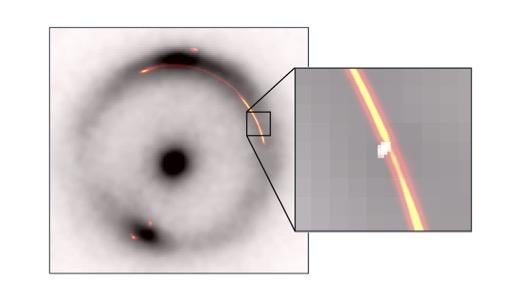
Lowest-mass object yet detected via gravitational lensing
Using a global network of telescopes, astronomers have detected the lowest-mass dark object yet found in the universe. Finding more such objects and understanding their nature could rule out some theories about the nature of dark matter, the mystery substance that makes up about a quarter of the universe. The work is described in two papers published Oct. 9 in Nature Astronomy and Monthly Notices of the Royal Astronomical Society.
Because the object does not emit any light or other radiation, it was detected by the way its gravity distorts light passing through or near it. This effect is called gravitational lensing. Based on the distortion, astronomers can infer the amount of matter in the unseen object.
In fact, the new object is so small that it was detected by inducing a small pinch in the distorted image caused by a much larger object, like a flaw in a funhouse mirror.

Figure caption: The black ring and central dot show infrared image of a distant galaxy distorted by a gravitation lens. Orange/red shows radio waves from the same object. The inset shows a pinch caused by another, much smaller, dark gravitational lens (white blob).
“It’s an impressive achievement to detect such a low mass object at such a large distance from us,” said Chris Fassnacht, professor in the Department of Physics and Astronomy at the University of California, Davis, who is a co-author on the Nature Astronomy paper. “Finding low-mass objects such as this one is critical for learning about the nature of dark matter.”
The mystery object has a mass about 1 million times that of our Sun. Its nature is unknown: It could be a clump of dark matter 100 times smaller than any previously detected, or it might be a very compact, inactive dwarf galaxy.
For more, see the full blog post by Andy Fell.
